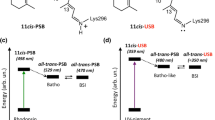Abstract
The physical properties of melanosomes have been shown to depend on water content. Herein, the ultraviolet absorption coefficient at λ = 244 nm for intact bovine choroidal melanosomes is determined from photoemission electron microscopy images recorded as a function of vacuum exposure. The dehydration of the melanosome under ultra-high vacuum manifests itself by a decrease in the absorption coefficient to about 60% of its initial value, and a concomitant increase in its image brightness. This change in the absorption of the melanosome is consistent with the influence of solvent polarity on the UV absorption coefficient of model systems for the pigment eumelanin, the predominant UV absorber contained in the choroid melanosomes.
Similar content being viewed by others
Notes and references
J. D. Simon, D. N. Peles, K. Wakamatsu, S Ito, Current Challenges in Understanding Melanogenesis: Bridging Chemistry, Biological Control, Morphology, and Function, Pigm. Cell Melanoma Res., 2009, 22, 563–579.
G. E. Costin, V. J. Hearing, Human skin pigmentation: melanocytes modulate skin color in response to stress, FASEB J., 2007, 21, 976–994.
S. L. Jacques, R. D. R. D. Glickman, J. A. J. A. Schwartz, Internal absorption coefficient and threshold for pulsed laser disruption of melanosomes isolated from retinal pigment epithelium, Proc. SPIE–Int. Soc. Opt. Eng., 1996, 2681, 468–476.
R. D. Glockman, S. L. Jacques, R. T. Hall, N. Kumar, Revisiting the internal absorption coefficient of the retinal pigment epithelium melanosome, Proc. SPIE–Int. Soc. Opt. Eng., 2001, 4257, 134–141.
D. H. Sliney, W. A. Palmisano, The evaluation of laser hazards., AIHAJ, 1968, 29, 425.
D. N. Peles, J. D. Simon, Direct Measurement of the Ultraviolet Absorption Coefficient of Single Retinal Melanosomes, Photochem. Photobiol., 2010, 86, 279–281.
D. N. Peles, E. Lin, K. Wakamatsu, S. Ito, J. D. Simon, Ultraviolet Absorption Coefficients of Melanosomes Containing Eumelanin As Related to the Relative Content of DHI and DHICA, J. Phys. Chem. Lett., 2010, 1, 2391–2395.
D. N. Peles, J. D. Simon, The Ultraviolet Absorption of Human Iridal Melanosomes Decreases with Increasing Pheomelanin Content, J. Phys. Chem. B, 2010, 114, 9677–9683.
K. Wakamatsu, S. Ito, Advanced chemical methods in melanin determination, Pigm. Cell Res., 2002, 15, 174–183.
J. D. Simon, L. Hong, D. N. Peles, Insights into Melanosomes and Melanin from some Interesting Spatial and Temporal Properties, J. Phys. Chem. B, 2008, 112, 13201–13217.
Y. Liu, L. Hong, K. Wakamatsu, S. Ito, B. B. Adhyaru, C.-Y. Cheng, C. R. Bowers, J. D. Simon, Comparisons of the Structural and Chemical Properties of Melanosomes Isolated from Retinal Pigment Epithelium, Iris, and Choroid of Newborn and Mature Bovine Eyes, Photochem. Photobiol., 2005, 81, 510–516.
L. Hong, J. D. Simon, Physical and Chemical Characterization of Iris and Choroid Melanosomes Isolated from Newborn and Mature Cows, Photochem. Photobiol., 2005, 81, 517–523.
E. Bucher, S. Schulz, M. C. Luxsteiner, P. Munz, U. Gubler, F. Greuter, Work function and barrier heights of transition-metal silicides, Appl. Phys. A: Solids Surf., 1986, 40, 71–77.
A. Samokhvalov, L. Hong, Y. Liu, J. Garguilo, R. J. Nemanich, G. S. Edwards, J. D. Simon, Oxidation Potentials of Human Eumelanosomes and Pheomelanosomes, Photochem. Photobiol., 2005, 81, 145–148.
H. P. Marques, A. R. Canario, A. M. C. Moutinho, O. M. N. D. Teodoro, Tracking hydroxyl adsorption on TiO2 (110) through secondary emission changes, Appl. Surf. Sci., 2009, 255, 7389–7393.
G. Rocker, W. Gopal, Chemisorption of H2 and CO on stoichiometric and defective TiO2(110), Surf. Sci., 1986, 175, L675–L680.
M. G. Bridelli, P. R. Crippa, Infrared and water sorption studies of the hydration structure and mechanism in natural and synthetic melanin, J. Phys. Chem. B, 2010, 114, 9381–9390.
M. M. Jastrzebska, H. Isotalo, J. Paloheimo, H. Stubb, Electrical conductivity of synthetic DOPA-melanin polymer for different hydration states and temperatures, J. Biomater. Sci., Polym. Ed., 1996, 7, 577–586.
A. B. Mostert, K. J. P. Davy, J. L. Ruggles, B. J. Powell, I. R. Gentle, P. Meredith, Gaseous Adsorption in Melanins: Hydrophilic Biomacromolecules with High Electrical Conductivities, Langmuir, 2010, 26, 412–416.
S. P. Nighswander-Rempel, I. B. Mahadevan, P. V. Bernhardt, J. Butcher, P. Meredith, Solvochromic effects in model eumelanin compounds, Photochem. Photobiol., 2008, 84, 620–626.
A. Pezzella, A. Iadonisi, S. Valerio, L. Panzella, A. Napolitano, M. Adinolfi, M. d’Ischia, Disentangling Eumelanin “Black Chromophore”: Visible Absorption Changes As Signatures of Oxidation State- and Aggregation-Dependent Dynamic Interactions in a Model Water-Soluble 5,6-Dihydroxyindole Polymer, J. Am. Chem. Soc., 2009, 131(42), 15270–15275.
B. C. Garrett, D. A. Dixon, D. M. Camaioni, D. M. Chipman, M. A. Johnson, C. D. Jonah, G. A. Kimmel, J. H. Miller, T. N. Rescigno, P. J. Rossky, S. S. Xantheas, S. D. Colson, A. H. Laufer, D. Ray, P. F. Barbara, D. M. Bartels, K. H. Becker, K. H. Bowen, Jr., S. E. Bradforth, I. Carmichael, J. V. Coe, L. R. Corrales, J. P. Cowin, M. Dupuis, K. B. Eisenthal, J. A. Franz, M. S. Gutowski, K. D. Jordan, B. D. Kay, J. A. LaVerne, S. V. Lymar, T. E. Madey, C. W. McCurdy, X D. Meisel, S. Mukamel, A. R. Nilsson, T. M. Orlando, N. G. Petrik, S. M. Pimblott, J. R. Rustad, G. K. Schenter, S. J. Singer, A. Tokmakoff, L.-S. Wang, C. Wittig, T. S. Zwier, Role of Water in Electron-Initiated Processes and Radical Chemistry: Issues and Scientific Advances, Chem. Rev., 2005, 105, 355–389.
Author information
Authors and Affiliations
Corresponding author
Rights and permissions
About this article
Cite this article
Lin, E., Peles, D.N. & Simon, J.D. The effect of hydration on the UV absorption coefficient of intact melanosomes. Photochem Photobiol Sci 11, 687–691 (2012). https://doi.org/10.1039/c2pp05233d
Received:
Accepted:
Published:
Issue Date:
DOI: https://doi.org/10.1039/c2pp05233d




